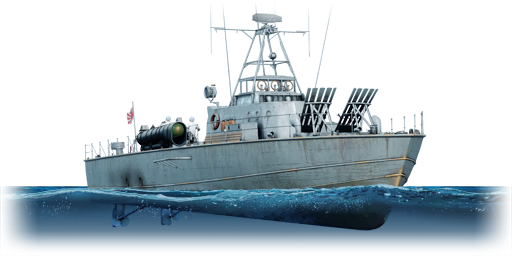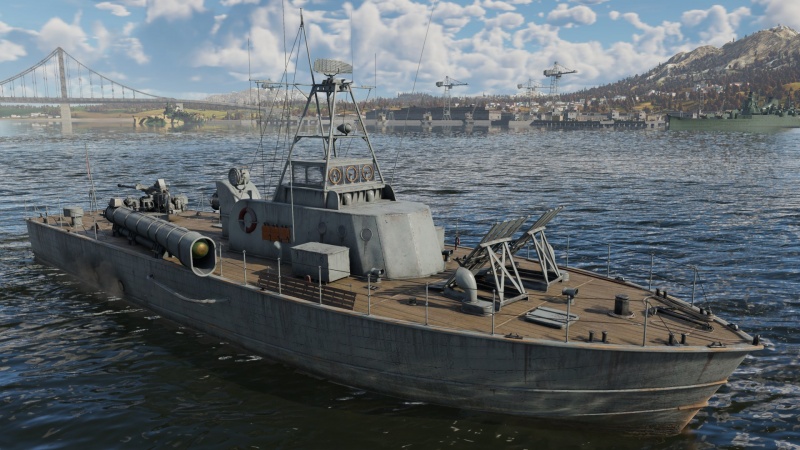PT-802
Contents
Description
PT-802, also known as Torpedo Boat No.2, was the second vessel of the 1-Go torpedo boats operated by the Japan Maritime Self-Defence Force. Laid down in May 1955 at Hitachi Shipbuilding's Kanagawa facility, launched in August 1955 and commissioned November 1956 she was assigned to the Yokosuka District. PT-802 joined the newly formed 1st Torpedo Boat Squadron in November 1956, which was later reorganised in 1959. By March 1970, she was reclassified as a Special Service Ship, with a designation YAS-49, to serve in the Practical Experimentation Unit. Finally, she was decommissioned on 31 March 1973.
The Type 1, PT-802 is a Japanese motor torpedo boat introduced in Update "Dance of Dragons" as one of the later additions to the low-BR Japanese MTBs. Its main highlight is the 40 mm Bofors, making it one of the lowest BR vessels equipped with such a high-calibre autocannon (in this regard, it can be compared with the MAS 441, introduced in the same update). This impressive armament, however, comes at a cost, with several disadvantages: limited firing arcs, a fragile hull, sub-par torpedoes, and rocket-launched depth charges that are challenging to use.
General info
Survivability and armour
Talk about the vehicle's armour. Note the most well-defended and most vulnerable zones, e.g. the ammo magazine. Evaluate the composition of components and assemblies responsible for movement and manoeuvrability. Evaluate the survivability of the primary and secondary armaments separately. Don't forget to mention the size of the crew, which plays an important role in fleet mechanics. Save tips on preserving survivability for the "Usage in battles" section. If necessary, use a graphical template to show the most well-protected or most vulnerable points in the armour.
Mobility
Write about the ship's mobility. Evaluate its power and manoeuvrability, rudder rerouting speed, stopping speed at full tilt, with its maximum forward and reverse speed.
| Mobility Characteristics | |||
|---|---|---|---|
| Game Mode | Upgrade Status | Maximum Speed (km/h) | |
| Forward | Reverse | ||
| AB | |||
| Upgraded | 73 | 27 | |
| RB/SB | |||
| Upgraded | 52 | 19 | |
Modifications and economy
Armament
Primary armament
Provide information about the characteristics of the primary armament. Evaluate their efficacy in battle based on their reload speed, ballistics and the capacity of their shells. Add a link to the main article about the weapon: {{main|Weapon name (calibre)}}. Broadly describe the ammunition available for the primary armament, and provide recommendations on how to use it and which ammunition to choose.
- Universal: AP-T · HEFI-T
- 40 mm AP clips: AP-T · AP-T · AP-T · HEFI-T
- 40 mm HE clips: HEFI-T · HEFI-T · HEFI-T · AP-T
| Penetration statistics | |||||||
|---|---|---|---|---|---|---|---|
| Ammunition | Penetration @ 0° Angle of Attack (mm) | ||||||
| 10 m | 100 m | 500 m | 1,000 m | 1,500 m | 2,000 m | ||
| HEFI-T | 3 | 3 | 3 | 3 | 3 | 3 | |
| AP-T | 81 | 78 | 68 | 58 | 49 | 41 | |
| Shell details | ||||||||||||
|---|---|---|---|---|---|---|---|---|---|---|---|---|
| Ammunition | Velocity (m/s) |
Projectile mass (kg) |
Fuse delay (m) |
Fuse sensitivity (mm) |
Explosive mass (TNT equivalent) (g) |
Ricochet | ||||||
| 0% | 50% | 100% | ||||||||||
| HEFI-T | 874 | 0.9 | 0 | 0.1 | 67.13 | 79° | 80° | 81° | ||||
| AP-T | 874 | 0.89 | - | - | - | 47° | 60° | 65° | ||||
Additional armament
Describe the available additional armaments of the ship: depth charges, mines, torpedoes. Talk about their positions, available ammunition and launch features such as dead zones of torpedoes. If there is no additional armament, remove this section.
Usage in battles
Describe the technique of using this ship, the characteristics of her use in a team and tips on strategy. Abstain from writing an entire guide – don't try to provide a single point of view, but give the reader food for thought. Talk about the most dangerous opponents for this vehicle and provide recommendations on fighting them. If necessary, note the specifics of playing with this vehicle in various modes (AB, RB, SB).
Pros and cons
Pros:
- The Bofors L/60 Mark 3 autocannon provides excellent firepower
Cons:
- Very awkward gun placement: The superstructure prevents firing forward, and the torpedo tubes limit gun depression
- Wooden structure cannot withstand even low-calibre machine gun fire
- No secondary or anti-aircraft (AA) armament: Incoming enemy aircraft must be detected in time and manually engaged
- Torpedoes have a low explosive yield and are among the slowest in the game
- The rocket-powered depth charges lack aiming tools and have a significant flight time, making them very unlikely to hit anything other than the largest, slowest vessels.
History
PT-802, also known as Torpedo Boat No.2, was the second vessel of the 1-Go class torpedo boats operated by the Japan Maritime Self-Defence Force in the post-war period. She was laid down on 18 May 1955 at Hitachi Shipbuilding's Kanagawa facility, launched on 6 August 1955 and commissioned on 15 November 1956.
The 1-Go torpedo boats were notable for their wooden hulls, constructed from Taiwanese cypress for the exterior planking and zelkova wood for structural components. PT-802 featured a modified V-shaped hull (named by the Japanese designers Omega-plane (オメガプレーンであ)), intended to enhance speed and manoeuvrability. Powered by two Mitsubishi YV20ZC15/20 diesel engines, each producing 2,000 horsepower, the vessel was capable of sustaining 30 knots. Its armament included a single 40 mm Bofors Mark 3 mounted on the aft deck, two Mousetrap anti-submarine rocket launchers on the foredeck, and two HO-101 533mm torpedo tubes positioned amidships on both sides.
Upon commissioning, PT-802 was assigned to the Yokosuka District (横須賀地方隊) of the JMSDF. On 16 November 1956, it joined the newly established 1st Torpedo Boat Squadron (第1魚雷艇隊) alongside Torpedo Boats No.1, No.5, and No.6. The squadron was reorganised on 1 June 1959. During its service, PT-802 contributed to coastal defence operations and participated in various naval exercises.
On 2 March 1970, the vessel was reclassified as a special service ship and renamed YAS-49 (abbreviation for Special Service Ship 49 - が特務船49号). It was then assigned to the Practical Experimentation Unit, where it played a role in testing and development of a new tactics and as a technology test-bed. PT-802 was decommissioned on 31 March 1973, concluding its 17-year service in the JMSDF.
Media
Excellent additions to the article would be video guides, screenshots from the game, and photos.
See also
Links to articles on the War Thunder Wiki that you think will be useful for the reader, for example:
- reference to the series of the ship;
- links to approximate analogues of other nations and research trees.
External links
| Hitachi Shipbuilding Corporation (日立造船株式会社) | |
|---|---|
| Torpedo Boats (魚雷艇) | |
| Type 1-class | PT-802 |
| Escort Boats (小護衛艇) | Ha-Go (mod. 1) |
| Escort Ships (海防艦) | |
| Hiburi-class | Syonan |
| Japan boats | |
|---|---|
| Motor torpedo boats | Type T-1 · Type T-14 · Type T-14 (mod. 1) · Type T-38 · Type T-51a · Type T-51b |
| PT-802 · PT-808 · PT-15 | |
| Motor gun boats | Ha-Go (mod. 1) · Type 4 (mod. 2) · Type 4 (Mod 4) |
| Asagao (YTE-01) · PG 02 | |
| Armoured gun boats | Soukou-Tei · Soukou-Tei No.4 |
| Gunboats | Chidori |





